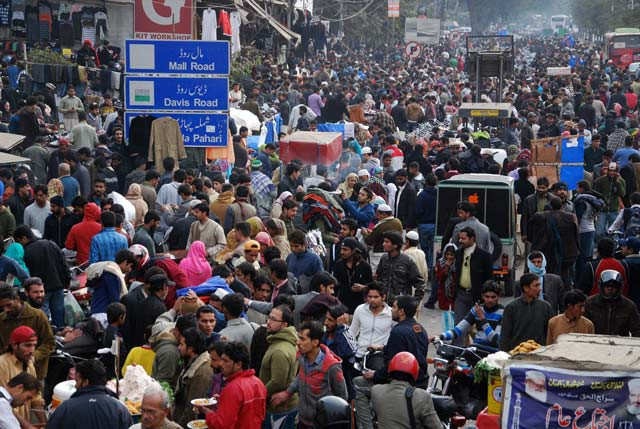
The population was just over 130 million in 1998, the year when the 5th census had been conducted. This means the country has seen a 57% increase in the population at an annual rate of 2.4%.
The government had deployed nearly 118,000 officials escorted by tens of thousands of troops and police to carry out the 70-day data-gathering drive in March launched on the orders of the Supreme Court.
The majority of the people – 52.9% to be precise – still live in Punjab, but its share in the population pie has declined when compared with the 1998 census results.
Balochistan and Khyber-Pakhtunkhwa are the beneficiaries of the reduction in Punjab’s share, as Sindh’s share in the total population remains unchanged – at 23%.
This might result in a proportionate reduction in the allocation of the National Assembly seats of Punjab, as well as its share in the federal divisible pool, although the overall number of seats of all the federating units would boost due to a 75.4 million increase in the population over the past 19 years. About 82% of the federal divisible pool is distributed on the basis of population.
Why the census is important for Pakistan
According to the summary results, the country’s predominant majority – 132.189 million or 63.6% – still lives in rural areas. This ratio was 65.6% in 1998 when the last headcount was conducted.
The urban population stands at 75.58 million, which is roughly 36.4% of the country’s population. In 1998, the share of the urban population was 32.52%.
Sindh is the most urbanised province having 52.02% population in urban areas – a result that could disturb rural-urban quotas of the provincial assembly seats and jobs.
Of the total urban population of the province, 68% is concentrated in three major cities – Karachi, Hyderabad and Sukkur.
Urbanisation-wise, Punjab stands second where 36.71% population lives in cities. The least urbanised province is K-P.
The CCI –- the constitutional body headed by the prime minister with four chief ministers as its members – discussed the provisional summary results on Friday.
“However, the final results will be available next year. The CCI decided that the figures will be further debated in the Inter-Provincial Coordination Committee (IPCC) where a strategy will be devised about the future course of action,” said a source.
Population census source of fear and hope for minorities
“After discussing the statistics in the IPCC, the census results will be presented to the federal cabinet for approval.”
There was a debate in the CCI about whether to hold the next general election on the basis of new results, as the law does not permit fresh delimitation of constituencies on the basis of provisional results, said sources.
They said the Election Commission of Pakistan (ECP) had informed the government that it may hold the next general election on the basis of the new census results, if the final results are provided by October this year.
Sources said the CCI discussed the possibility of amending the relevant laws to allow holding of the general elections on the basis of the provisional results.
The population census results are exclusive of Azad Jammu & Kashmir and Gilgit-Baltistan.
The Pakistan Bureau of Statistics (PBS) conducted the census in the two territories but did not release their results as part of the country’s population due to their special status.
Meanwhile, women’s share in the total population has increased about 1% during the past 19 years. The female population stands at 101.314 million, which is 48.8% of the total headcount, according to the 2017 results. In 1998, the female population ratio was 47.9%.
Pakistan at 80: the next 10 years
The male population has increased to 106.449 million or 51.2%. Meanwhile, there are 10,418 transgender (0.05%) in the country.
The PBS had conducted the exercise in two phases across Pakistan under the supervision of the military. The population results will be used to determine the federating units’ share in the federal divisible pool, allocations and delimitation of the National Assembly and provincial assemblies’ seats and determination of provincial job quotas.
Punjab
Punjab still remains the most populated province with 110.01 million inhabitants, forming 52.94% of the total population.
The province’s population has increased by 36.4 million in past 19 years which is 49.4% higher than the 1998 statistics. In 1998, Punjab’s share in the total population was 55.62%.
Punjab’s population has grown at an annual rate of 2.13%, – the lowest pace of growth among all the federating units and also lower than the national average.
The share of urban population in Punjab has increased to 36.71% but its 63.9% population still lives in rural areas. There are now 49% women in Punjab as compared to 48.2% in 1998.
Sindh
Sindh remains the second most populated province with 47.886 million people, which is 23% of the total population.
Sindh’s population has grown by 57.3% or 17.44 million during the past 19 years, but its overall share in the national population remains stagnant.
Sindh’s annual growth rate remained 2.41% – slightly above the national average. Sindh’s urban population has increased to 52% as compared to 48.9% in 1998.
There are 48% or 22.96 million women in Sindh – which is 1% up when compared with 1998 results.
CCI meeting delayed for a second time
Khyber-Pakhtunkhwa
K-P’s population stands at 30.523 million – which is 14.69% of the total population as against 13.4% in 1998.
Its population has grown by 12.78 million or 72% – the second maximum increase. The annual growth rate in K-P stands at 2.89% – the third highest among all the federating units and above the national average.
The urban population in K-P has slightly increased to 17.67% of the provincial population. There were 15.05 million women in the province – 49.3% of the provincial population.
Balochistan
Balochistan’s population stands at 12.344 million or 5.94% of the total population, according to the 2017 census.
During the past 19 years, its population has grown by 5.8 million or 88% – the maximum increase in the population of any federating unit in terms of percentage.
Its share was only 4.96% as per the 1998 census.
The province’s annual growth rate remained 3.37% – the highest after the Islamabad territory and far above the national average. The urban population in Balochistan is 27.54% – significantly better than 23.3% of 1998.
There are 5.86 million women in Balochistan – 47.5% of the unit’s total population.
ICT
The Islamabad Capital Territory (ICT) population stands at 2.0 million, which is 1.2 million higher than the 1998 census. In percentage terms, it has grown by 149%.
Islamabad has the highest annual growth rate of 4.91%, which is more than double of the national average. The share of urban population in Islamabad has significantly declined from 65% to 50.57%. There are about one million or 47.2% women in the capital territory.
FATA
The population of the Federally Administrated Tribal Areas stands at 5.1 million. There has been a 1.8 million increase in the population of the autonomous region, registering 57% increase.
The annual growth rate in FATA remained 2.41%, equal to the national average. The urban population is only 2.83% while 49% are women.








1726054615-0/OpenAI-(2)1726054615-0-270x192.webp)









COMMENTS
Comments are moderated and generally will be posted if they are on-topic and not abusive.
For more information, please see our Comments FAQ